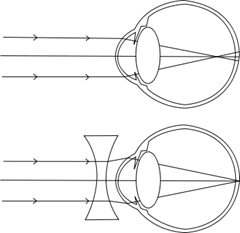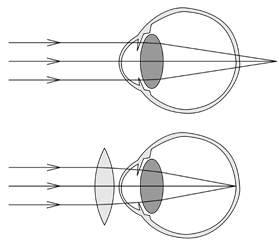When do we consider a person to be myopic or hypermetropic? Explain using diagrams how the defects associated with myopic and hypermetropic eye can be corrected?
OR
Explain the refraction of light through a triangular glass prism using a labelled ray diagram. Hence define the angle of deviation.
When a person is unable to see distant objects clearly but can see nearby objects clearly, then he is considered to be myopic. If a person is able to see distant objects clearly but cannot see nearby object clearly, then he is considered to be hypermetropic.
The short- sightedness or myopia is corrected by using a concave lens, which diverges and shifts the image to the retina as follows:

Long-sightedness or hypermetropia is corrected by using a convex lens, which converges and shifts the image to the retina as follows:

OR

The light ray PQ enters the triangular glass prism ABC at point E at an angle of incidence i. Since the medium of the prism is denser than the surrounding, the light ray is refracted at an angle of refraction r towards the normal NN’. The light ray RS leaves the prism at F with an angle of emergence e. Since the medium of the surrounding is rarer than the prism medium, the light ray is refracted away from the normal MM’.
It may be observed that the light ray entering the prism is not parallel to the light ray emerging from the prism. There is some deviation in its path. The angle through which the light ray deviates from its original path is called the angle of deviation D. The angle of deviation can be illustrated by extending the ray of incidence PQ up to H and the emerging ray RS up to G. The angle between these two lines gives the angle of deviation D.
If a beam of white light is passed through a glass prism, it is separated into its constituent colors. This phenomenon is known as dispersion.